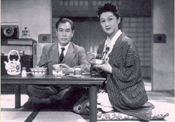 The Flavor of Green Tea Over Rice, 1950. Revisiting themes of marital complacency and mutual respect as his earlier domestic comedy What Did the Lady Forget?, The Flavor of Green Tea Over Rice demonstrates unusually dynamic camerawork a later period, postwar Ozu film, featuring several low angle tracking shots – often placed as interstitial scenes in lieu of his more familiar ‘pillow’ shots – that move through the empty spaces of the Satake’s upper middle-class household. In an early episode, Taeko (Michiko Kogure) fabricates an ill-conceived excuse of going away in order to care for a friend with appendicitis (despite having to switch the patient’s identity midway through the flimsy explanation after her niece Setsuko (Keiko Tsushima) unexpectedly returns home and ruins the premise of the concocted story) in order to go on holiday with friends at a spa resort. As Taeko alternately belittles her husband Mokichi (Shin Saburi) and goads Setsuko into accepting a marriage interview, the two invariably seek refuge outside their home, eventually finding their way to a pachinko parlor operated by Mokichi’s former military colleague Hirayama (Chishu Ryu). The film’s title, derived from Mokichi’s humble taste for the comfortable and familiar dish, invariably proves to be a reflection of the film itself: a subtle, pleasant, and simple experience that evokes a cherished personality of meaning.
The Flavor of Green Tea Over Rice, 1950. Revisiting themes of marital complacency and mutual respect as his earlier domestic comedy What Did the Lady Forget?, The Flavor of Green Tea Over Rice demonstrates unusually dynamic camerawork a later period, postwar Ozu film, featuring several low angle tracking shots – often placed as interstitial scenes in lieu of his more familiar ‘pillow’ shots – that move through the empty spaces of the Satake’s upper middle-class household. In an early episode, Taeko (Michiko Kogure) fabricates an ill-conceived excuse of going away in order to care for a friend with appendicitis (despite having to switch the patient’s identity midway through the flimsy explanation after her niece Setsuko (Keiko Tsushima) unexpectedly returns home and ruins the premise of the concocted story) in order to go on holiday with friends at a spa resort. As Taeko alternately belittles her husband Mokichi (Shin Saburi) and goads Setsuko into accepting a marriage interview, the two invariably seek refuge outside their home, eventually finding their way to a pachinko parlor operated by Mokichi’s former military colleague Hirayama (Chishu Ryu). The film’s title, derived from Mokichi’s humble taste for the comfortable and familiar dish, invariably proves to be a reflection of the film itself: a subtle, pleasant, and simple experience that evokes a cherished personality of meaning.
The Munekata Sisters, 1950. The film follows the plight of the upper beautiful, middle-class Munekata sisters – the conservative and traditional married older sister, Setsuko (Kinuyo Tanaka) (dressed in a kimono) and the liberal minded and free-spirited younger sister Mariko (Hideko Takamine) (dressed in Western attire) – as they struggle to build a new life in postwar Tokyo away from their beloved, ailing father (Chishu Ryu) by running a small bar. While visiting the temples of Kyoto, Setsuko remembers happier times with a former suitor named Hiroshi (Ken Uehara), a nostalgic sentiment that the more forward-minded Mariko begins to encourage her to act on by expressing her contempt for Setsuko’s unemployed, hard-drinking husband (Masayuki Mori). Cultivating a friendship with the charming Hiroshi, now a successful furniture maker in Kobe, Mariko attempts to reunite the unrequited lovers. Ozu juxtaposes the serene and contemplative images of Kyoto (the ancient capital of Japan) with the progressive and modernized (and industrialized) images of Tokyo and Kobe in order to illustrate the dichotomy and cultural conflict between tradition and modernity in postwar Japan.
Late Spring, 1949. Since every Ozu fan will be familiar with this film, I just wanted to note that two things that particularly struck me on watching this film: (1) from my vantage point (seated back row, center), it does seem as though my perspective is constantly symmetric whether characters are near or far, suggesting that Ozu’s peculiar camera angle maintains correct proportionality irrespective of distance (as Tadao Sato noted); and (2) when Noriko (Setsuko Hara) repeatedly asks her father, Professor Somiya (Chishu Ryu) if he really does intend to remarry, Somiya gives a noticeable facial tick before nodding in the affirmative – a subtle nuance (and quintessentially Ozu), that indicates that the father is telling a fib.
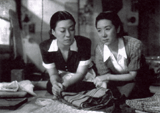 A Hen in the Wind, 1948. A somber, bleak, and uncharacteristically violent Ozu postwar film, A Hen in the Wind follows the plight of a dressmaker named Tokiko (Kinuyo Tanaka) who lives meagerly as a boarder in a modest house in a working class district with her young son Hiroshi. Awaiting her husband’s repatriation from Manchuria, Tokiko subsists through dressmaking and the occasional sale of household possessions. Despite their continued hardship, increasing poverty (due to rampant inflation and scarcity of goods), and uncertainty over her husband’s return, Tokiko has resisted the temptation to work in a brothel in order to earn extra money. However, when Hiroshi unexpectedly falls ill, Tokiko is compelled to sacrifice her dignity in order to tender payment for accrued medical expenses. Paralleling Tokiko’s desperate act with the reluctant livelihood of a young prostitute, Ozu forms an austere perspective of postwar Japanese life that is harrowing and life-affirming, tragic and hopeful, compassionate and indicting.
A Hen in the Wind, 1948. A somber, bleak, and uncharacteristically violent Ozu postwar film, A Hen in the Wind follows the plight of a dressmaker named Tokiko (Kinuyo Tanaka) who lives meagerly as a boarder in a modest house in a working class district with her young son Hiroshi. Awaiting her husband’s repatriation from Manchuria, Tokiko subsists through dressmaking and the occasional sale of household possessions. Despite their continued hardship, increasing poverty (due to rampant inflation and scarcity of goods), and uncertainty over her husband’s return, Tokiko has resisted the temptation to work in a brothel in order to earn extra money. However, when Hiroshi unexpectedly falls ill, Tokiko is compelled to sacrifice her dignity in order to tender payment for accrued medical expenses. Paralleling Tokiko’s desperate act with the reluctant livelihood of a young prostitute, Ozu forms an austere perspective of postwar Japanese life that is harrowing and life-affirming, tragic and hopeful, compassionate and indicting.
A Straightforward Boy, 1930. A purely fun, entertaining, and lighthearted short film, A Straightforward Boy follows the (mis) adventures of a kidnapper (Tatsuo Saito) who, on an idyllic, sunny day (that, as the film comments, is conducive for such nefarious activities), lures a cherubic, bespectacled boy (Tomio Aoki) with toys and treats back into the hideout. However, when the mischievous and precocious boy becomes too much of a handful, the kidnapper’s attempts to get rid of him proves to be a greater challenge than the abduction itself.
 There Was a Father, 1942. A widowed high school teacher named Horikawa (Chishu Ryu) experiences a traumatic episode during a school field trip and consequently, decides to abandon his profession and move to a small town where his son, Ryohei may obtain a good education. However, unable to earn enough money to pay for Ryohei’s boarding school, Horikawa decides to return to Tokyo to find a better paying job. The separation between father and son would prove to be permanent and irreversible, as Ryohei completes his studies and becomes a schoolteacher in a rural province while his father continues to work in Tokyo. The film is a more sentimentally subdued – but nevertheless, affecting – quintessential Ozu home drama on parental obligation and the inevitable dissolution of family. At this juncture, Ozu’s camera is more static and understated (similar to Brothers and Sisters of the Toda Family), such as the repeated extended sequence of father and son fishing in synchrony at a lake: first, when Ryohei was a young boy, then later, as a grown man vacationing with his father at a resort.
There Was a Father, 1942. A widowed high school teacher named Horikawa (Chishu Ryu) experiences a traumatic episode during a school field trip and consequently, decides to abandon his profession and move to a small town where his son, Ryohei may obtain a good education. However, unable to earn enough money to pay for Ryohei’s boarding school, Horikawa decides to return to Tokyo to find a better paying job. The separation between father and son would prove to be permanent and irreversible, as Ryohei completes his studies and becomes a schoolteacher in a rural province while his father continues to work in Tokyo. The film is a more sentimentally subdued – but nevertheless, affecting – quintessential Ozu home drama on parental obligation and the inevitable dissolution of family. At this juncture, Ozu’s camera is more static and understated (similar to Brothers and Sisters of the Toda Family), such as the repeated extended sequence of father and son fishing in synchrony at a lake: first, when Ryohei was a young boy, then later, as a grown man vacationing with his father at a resort.
Walk Cheerfully, 1930. An unusually fast moving, atypically stylized (rather than composed), and multi-plot Ozu film that bears a hint of noir, Walk Cheerfully is a humorous and affectionate film that is replete with homages to classic silent films, from a prominently placed, life-sized Clara Bow poster to a gangster moll sporting a Louise Brooks haircut. The film resembles a Chaplinesque romantic comedy drama as a petty thief and career criminal named Kenji (Minoru Takada) – also known through the moniker Ken the Knife – performs a surveillance of a jewelry store with his accomplice and targets an honest, kind-hearted office clerk whom he mistakenly believes is a wealthy woman after she is observed collecting a diamond ring from the jeweler.
 The Brothers and Sisters of the Toda Family, 1941. On the occasion of the family patriarch’s 69th birthday, the noble and privileged Toda family has assembled for a formal commemorative photograph and a dinner banquet that would prove to be their father’s last. Forced to sell the family home in order to settle their father’s unresolved, business-related debts, Mrs. Toda (Ayako Katsuragi) and the youngest daughter Setsuko (Mieko Takamino) – with a devoted domestic servant (Choko Iida) and mynah bird in tow – are sent to live with the oldest son, Shinichiro (Tatsuo Saito), before being politely passed off from one sibling to another. Expounding on (and prefiguring) similar themes of filial duty and respect to elders as Tokyo Story with the social commentary on the vanishing way of life of the feudal era, socially prominent merchant class (note the samurai clan armor that decorates the hallway of the Toda residence), The Brothers and Sisters of the Toda Family is a poignant and graceful film that exemplifies Ozu’s later, more insular, understated, and distilled) gendai-geki home dramas.
The Brothers and Sisters of the Toda Family, 1941. On the occasion of the family patriarch’s 69th birthday, the noble and privileged Toda family has assembled for a formal commemorative photograph and a dinner banquet that would prove to be their father’s last. Forced to sell the family home in order to settle their father’s unresolved, business-related debts, Mrs. Toda (Ayako Katsuragi) and the youngest daughter Setsuko (Mieko Takamino) – with a devoted domestic servant (Choko Iida) and mynah bird in tow – are sent to live with the oldest son, Shinichiro (Tatsuo Saito), before being politely passed off from one sibling to another. Expounding on (and prefiguring) similar themes of filial duty and respect to elders as Tokyo Story with the social commentary on the vanishing way of life of the feudal era, socially prominent merchant class (note the samurai clan armor that decorates the hallway of the Toda residence), The Brothers and Sisters of the Toda Family is a poignant and graceful film that exemplifies Ozu’s later, more insular, understated, and distilled) gendai-geki home dramas.
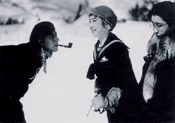 Days of Youth, 1929. As the film opens, a gregarious loafer named Watanabe (Ichiro Yuki) turns away a young man who has inquired about a sign on the window for a room for rent, explaining that he had just rented the room earlier that day. Moments later, an attractive young woman inquires about the same room and, attempting to get into her good graces, Watanabe remarks that he is in the process of vacating and that the room is available. With nowhere to go, he moves into the apartment of his meek, bookish friend Yamamoto (Tatsuo Saito) who, unbeknownst to him, is enamored with the same young woman. After completing their final examinations, the two friends decide to bide time waiting for their final grades by competing for the affection of the young woman at a ski resort, resulting in a series of misadventures for the novice skier Yamamoto. The earliest extant film by Ozu, Days of Youth is a whimsical, amusing, and entertaining fusion of physical and situational comedy. Most noteworthy in the film is the absence of Ozu’s familiar ‘pillow’ shots that are functionally replaced by the use a bookend, long panning panorama shots of the city to convey placement and scenario.
Days of Youth, 1929. As the film opens, a gregarious loafer named Watanabe (Ichiro Yuki) turns away a young man who has inquired about a sign on the window for a room for rent, explaining that he had just rented the room earlier that day. Moments later, an attractive young woman inquires about the same room and, attempting to get into her good graces, Watanabe remarks that he is in the process of vacating and that the room is available. With nowhere to go, he moves into the apartment of his meek, bookish friend Yamamoto (Tatsuo Saito) who, unbeknownst to him, is enamored with the same young woman. After completing their final examinations, the two friends decide to bide time waiting for their final grades by competing for the affection of the young woman at a ski resort, resulting in a series of misadventures for the novice skier Yamamoto. The earliest extant film by Ozu, Days of Youth is a whimsical, amusing, and entertaining fusion of physical and situational comedy. Most noteworthy in the film is the absence of Ozu’s familiar ‘pillow’ shots that are functionally replaced by the use a bookend, long panning panorama shots of the city to convey placement and scenario.
I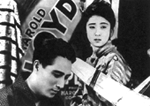 Graduated But…, 1929. A ten minute reconstruction of an otherwise lost film, I Graduated But… follows a trajectory of enlightenment towards humble acceptance as Ozu’s similarly titled, I Was Born But… as a recent college graduate named Tetsuo (Minoru Takada), unable to find employment at a position that he believes is commensurate with his education level (his only job offer is as an entry level office receptionist), is visited by his mother after misrepresenting his financial circumstances to her. While there is little material presented, the story does unfold linearly. However, Ozu’s development of plot through quietly observed interactions and situations – the essence of his cinema – is unavoidably compromised.
Graduated But…, 1929. A ten minute reconstruction of an otherwise lost film, I Graduated But… follows a trajectory of enlightenment towards humble acceptance as Ozu’s similarly titled, I Was Born But… as a recent college graduate named Tetsuo (Minoru Takada), unable to find employment at a position that he believes is commensurate with his education level (his only job offer is as an entry level office receptionist), is visited by his mother after misrepresenting his financial circumstances to her. While there is little material presented, the story does unfold linearly. However, Ozu’s development of plot through quietly observed interactions and situations – the essence of his cinema – is unavoidably compromised.
I Flunked But…, 1930. A college student’s (Tatsuo Saito) underhanded scheme to cheat on his final examinations backfires when the boarding house matron sends the shirt on which he has scribbled his notes out for laundry. Now faced with remaining as a student for another year and bearing the dubious distinction of being the only student in the household who did not graduate, he gradually adjusts to the reality of his deferred professional life, eventually turning his disappointment to optimism with the support and encouragement of his friends and a young waitress (Kinuyo Tanaka) who is devoted to him. Similar to the lighthearted comedy of Days of Youth, I Flunked But… is a hilarious and effervescent comedy on a young man’s unforeseen (and unintentionally) delayed passage to maturity and responsibility.
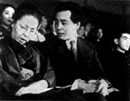 The Only Son, 1936. The Only Son is a quintessential Ozu home drama on the relationship between a widowed mother (Choko Iida) and her son, Ryosuke. Encouraged by her son’s ambitious elementary school teacher (Chishu Ryu), the mother slaves at a silk manufacturing factory, sacrificing personal and financial comfort and security, in order to support Ryosuke’s education so that he may grow up to be a “great man”. Thirteen years later, she travels to Tokyo to visit Ryosuke and finds that that his once seemingly bright future has become quashed by limited opportunity and personal obligations. Alternately poignant, comical, and bittersweet, the film is a thoughtful exposition of Ozu’s familiar themes of familiar estrangement and acceptance of life’s inevitable disappointments.
The Only Son, 1936. The Only Son is a quintessential Ozu home drama on the relationship between a widowed mother (Choko Iida) and her son, Ryosuke. Encouraged by her son’s ambitious elementary school teacher (Chishu Ryu), the mother slaves at a silk manufacturing factory, sacrificing personal and financial comfort and security, in order to support Ryosuke’s education so that he may grow up to be a “great man”. Thirteen years later, she travels to Tokyo to visit Ryosuke and finds that that his once seemingly bright future has become quashed by limited opportunity and personal obligations. Alternately poignant, comical, and bittersweet, the film is a thoughtful exposition of Ozu’s familiar themes of familiar estrangement and acceptance of life’s inevitable disappointments.
Kagamijishi, 1935. Kagamijishi is a short performance film intended to introduce non-native viewers to Kabuki theater and also to showcase the skill of Kikugoro IV, a legendary, multi-generation Kabuki artist. Ozu’s repeated fixed position shots (one on center stage, a second to the side of the stage, and a third from an upper balcony) are evident throughout the film. Although I’m unfamiliar with the vernacular of Kabuki theatre, the then middle-aged Kikugoro’s ability to transform himself from delicate maiden to possessed, ferocious beast by donning a lion mask is remarkable.
 What Did the Lady Forget?, 1937. A funny, lighthearted, but nevertheless, astute social satire, What Did the Lady Forget? centers on a genial college professor who, forced by his stern and domineering wife to play golf, fabricates an alibi and arranges to spend the evening at a student’s house. However, his plans are compromised when his assertive and progressive thinking niece decides to accompany him. Loosely reminiscent of Carl Theodor Dreyer’s Master of the House (without the imposing governess), the film is a highly engaging comedy on the need for reciprocity and mutual respect in human relationships.
What Did the Lady Forget?, 1937. A funny, lighthearted, but nevertheless, astute social satire, What Did the Lady Forget? centers on a genial college professor who, forced by his stern and domineering wife to play golf, fabricates an alibi and arranges to spend the evening at a student’s house. However, his plans are compromised when his assertive and progressive thinking niece decides to accompany him. Loosely reminiscent of Carl Theodor Dreyer’s Master of the House (without the imposing governess), the film is a highly engaging comedy on the need for reciprocity and mutual respect in human relationships.
Acquarello, 2003 [reprinted]